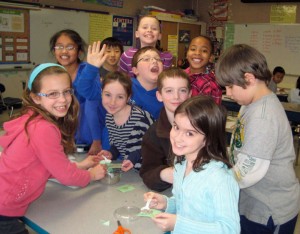Luce students get hands-on with rocks & minerals
By Ruth WeinerEditor’s note: Below is the fourth in an ongoing series of articles highlighting innovative education programs that have been made possible by a grant from the Canton Alliance for Public Education (CAPE), a non-profit, community-based foundation whose mission is to “promote innovative and productive programs that challenge students and teachers to achieve their true potential.”
 When third grade teacher Jennifer Barucci put a drop of vinegar on a rock to see if it would fizz, all her students’ eyes were focused on the demonstration; fingers pointed, and oohs and ahhs escaped as bubbles formed.
When third grade teacher Jennifer Barucci put a drop of vinegar on a rock to see if it would fizz, all her students’ eyes were focused on the demonstration; fingers pointed, and oohs and ahhs escaped as bubbles formed.
Student Megan Winkler explained the results of the science experiment: “Some rocks fizz and some don’t depending on what you expose them to.”
To enhance the rocks and minerals curriculum, Barucci applied for a Canton Alliance for Public Education grant. With the funds she received, she created a discovery kit containing dropper bottles and handheld microscopes capable of magnifying 30 times.
“By getting this grant, I could put together all the tools,” said Barucci, who has taught at the Luce Elementary School for four years. “Kids learn by doing. Because of the hands-on activities, this is the smoothest this unit has ever gone.”
After the initial observation, students gathered materials for small-group experiments and set off with their discovery kits to investigate the properties of rocks and sand. Their assignment was not only to write down what they saw through the hand microscopes, but also to illustrate their findings.
Absorbed in the procedure, student Michael Donovan glanced up in awe after staring into his microscope, a first for the majority of the students in the class.
“When I looked at them closely,” he said, “it showed me that rocks are different than they look to our eyes. I think of it as a little alien world.”
Student Daniel Curtis was equally amazed at the magnification: “It makes things bigger if you want to see something that you can’t see by yourself.”
Barucci, along with other third and fourth grade teachers, participated in an all-day workshop entitled How to Read a Rock, held at the Education Collaborative for Greater Boston in Waltham. They learned several new, exciting and innovative ways to enhance the rocks and minerals program.
“The workshop introduced us to hands-on activities that have been incorporated into our curriculum this school year,” Barucci said. “We are hopeful that students will have a better appreciation and understanding of rocks and minerals.”
Observation analysis of a rock includes determining its color, luster, and texture, which provide clues to identifying it as igneous, sedimentary, or metamorphic. A backyard fieldtrip to seek out a favorite rock produced creative results.
Student Anoushka Luis described her “pet rock” as sparkly and filled with purple, orange, brown, gray and black. “It is small and has a point that is kind of sharp,” she said. “It feels a bit bumpy and reminds me of a rhombus.”
Lizzie Tassinari noticed that her rock was purple with little sparkly edges. “It had dimples and was about the size of a baseball,” she wrote on the worksheet that accompanied the project.
Joseph Crowley’s rock was rough, shiny, and sharp. “It looks like a rhino and it has veins of blue,” he said.
Discussing the significance of the activities, student Drew Giglio said with rock-solid spirit, “It’s important to know about rocks so you can find out the facts and details of how they’re alike and different. Then you can categorize and classify them.”
Short URL: https://www.thecantoncitizen.com/?p=12625










